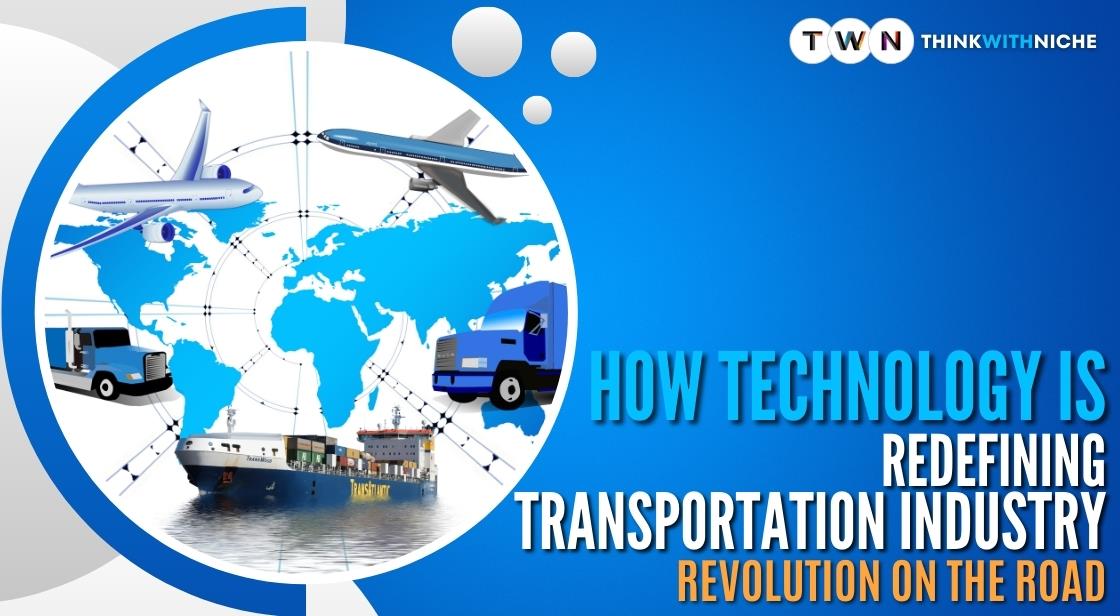How Technology is Redefining Transportation Industry: Revolution on the Road

Blog Post
The transportation industry, the backbone of our globalized world, is undergoing a radical transformation fueled by technological innovation.The transportation industry is undergoing a revolution fueled by technological advancements.
From self-driving cars and electric vehicles to connected infrastructure and drone deliveries, these innovations are fundamentally reshaping how we travel and move goods.
This article dives into the latest trends and breakthroughs redefining transportation, highlighting the potential benefits and challenges that lie ahead. We'll explore how autonomous vehicles (AVs) promise to revolutionize safety and accessibility, while electric vehicles (EVs) offer a cleaner alternative to combat climate change.
Additionally, connected vehicles utilizing the Internet of Things (IoT) are creating a network that improves efficiency and safety through real-time data exchange. Mobility as a Service (MaaS) platforms are further transforming personal transportation by offering seamless access to various options like ride-hailing and public transit.
Beyond personal travel, drones are making their mark on delivery services, particularly in remote areas. But the road to a sustainable future requires a multi-pronged approach.
We'll delve into advancements beyond EVs, exploring the potential of hydrogen fuel cells and the importance of sustainable car components made from bio-based and recycled materials.
Buckle up, as we explore how technology is redefining the transportation landscape for a cleaner, safer, and more efficient future.
Top Tech Trends Transforming Transportation:Revolution on the Road:
Transportation is the lifeblood of our globalized world, moving people and goods across vast distances. But the industry is undergoing a seismic shift, driven by a wave of technological advancements. From self-driving cars to electric vehicles and drone deliveries, technology is fundamentally reshaping how we travel and how goods are delivered.
This article delves into the latest trends and innovations that are redefining the transportation industry, highlighting the potential benefits and challenges that lie ahead.
Top Tech Trends Redefining Transportation
The transportation landscape is undergoing a seismic shift, driven by a wave of technological advancements. These trends are not just science fiction; they're actively shaping the way we travel and move goods today. Let's delve into the top five trends revolutionizing transportation:
1. Autonomous Vehicles (AVs): A Self-Driving Future
Undoubtedly, autonomous vehicles (AVs) are poised to transform transportation. These self-driving cars utilize a complex suite of sensors, cameras, radar, and LiDAR (Light Detection and Ranging) technology, coupled with powerful artificial intelligence (AI) to navigate roads without human input. While fully autonomous vehicles are still under development, pilot programs are underway in various cities worldwide.
a. Potential Benefits:
-
Safety: AVs promise to significantly improve road safety. Human error is a major factor in accidents – AVs, programmed to follow traffic rules and avoid obstacles, can drastically reduce crashes.
-
Accessibility: Self-driving cars offer increased mobility for individuals who cannot drive themselves, such as the elderly, visually impaired, or people with disabilities.
-
Reduced Congestion: AVs can communicate with each other and infrastructure, allowing for smoother traffic flow and potentially reducing congestion.
b. Example:
Waymo, a self-driving technology company owned by Alphabet (Google's parent company), launched a fully driverless ride-hailing service in Phoenix, Arizona, in 2023. This pilot program allows users to experience self-driving technology firsthand and provides valuable data for further development.
2. Electric Vehicles (EVs): Powering a Cleaner Future
Concerns about climate change and air pollution are driving the rapid adoption of electric vehicles (EVs). Unlike traditional gasoline-powered cars, EVs produce zero tailpipe emissions, making them a cleaner alternative. Advancements in battery technology are expanding EV range and affordability, while government incentives continue to accelerate their adoption.
a. Technological Advancements:
Solid-state battery technology is a promising development in the EV space. These batteries offer increased energy density, faster charging times, and improved safety compared to traditional lithium-ion batteries. While still under development, solid-state batteries have the potential to significantly enhance EV capabilities.
b. Example:
Tesla remains a leader in the EV market, with its Model Y electric SUV becoming the best-selling car (including gasoline-powered vehicles) in the United States in 2023. This highlights the growing consumer demand for EVs and their increasing mainstream appeal.
3. Connected Vehicles: The Internet of Things on the Road
The Internet of Things (IoT) is weaving its magic into the transportation sector, creating a network of "connected vehicles." These vehicles communicate with each other and with roadside infrastructure like traffic lights and smart signs, exchanging real-time data on traffic conditions, accidents, weather, and even available parking spaces.
a. Enhanced Safety and Efficiency:
Connected vehicle technology paves the way for features like collision avoidance systems that can warn drivers of potential hazards and automatically apply brakes if necessary. Additionally, real-time traffic data allows for dynamic route optimization, reducing travel time and congestion.
b. Example:
Ford's SYNC Connect system is an example of connected vehicle technology in action. This system allows drivers to connect their smartphones to their vehicles, enabling features like voice-activated navigation, hands-free calling, and real-time traffic updates.
4. Mobility as a Service (MaaS): A Shift from Ownership to Access
The concept of car ownership is evolving with the rise of Mobility as a Service (MaaS) platforms. These platforms offer a convenient, all-in-one app to access various transportation options, including ride-hailing services, car rentals, bike-sharing programs, and public transportation. This integrated approach promotes multi-modal transportation and reduces dependence on private vehicles.
a. Benefits Beyond Convenience:
MaaS platforms not only offer flexibility but also contribute to environmental sustainability by encouraging shared mobility options and reducing the number of vehicles on the road.
b. Example:
MaaS giant Uber recently partnered with public transportation authorities in several cities to offer seamless integration of ride-hailing services with local bus and train networks within their app. This collaboration provides users with a wider range of transportation options and encourages a shift towards multi-modal travel.
Also Read: How Technology is Redefining the Future of Media Landscape?
5. Drones: Taking Delivery to New Heights
Drones, also known as Unmanned Aerial Vehicles (UAVs), are taking flight in the transportation sector. These unmanned aerial vehicles hold immense potential for revolutionizing delivery services, particularly in remote areas or for time-sensitive packages. Additionally, drones can be used for infrastructure inspection, search and rescue operations, and traffic monitoring.
a. Regulatory Landscape:
a. Regulatory Landscape: Safety regulations and air traffic management are crucial aspects of drone integration. Governments worldwide are actively developing frameworks to address concerns and ensure safe airspace integration for drones. Here's a glimpse into some key areas of focus:
-
Drone Registration and Identification: Regulations mandate drone registration with authorities, assigning unique identification numbers that allow tracking and accountability.
-
Geo-fencing and No-Fly Zones: Restricted airspace zones are established around airports, sensitive government buildings, and other critical infrastructure to prevent drone interference with manned aviation.
-
Altitude and Payload Limits: Regulations may specify limitations on drone flight altitude and payload weight to mitigate potential safety risks.
-
Beyond-Visual-Line-of-Sight (BVLOS) Operations: Specific qualifications and authorizations are required for operating drones beyond the pilot's visual line of sight. This ensures responsible use and minimizes collision risks.
b. The Future of Drone Delivery:
Drone delivery is still in its early stages, but companies like Amazon's Prime Air and Alphabet's Wing are conducting pilot programs to test the feasibility and efficiency of drone-based deliveries. Regulatory clarity and public acceptance are key factors that will influence the widespread adoption of drone delivery services.
Example:
In 2024, Rwanda became the first African nation to implement a nationwide drone delivery network for essential medical supplies. This program demonstrates the potential of drones to bridge geographical gaps and improve access to critical resources in remote areas.
The Road to Zero-Emission Cars: A Multi-Pronged Approach
The transportation sector is a major contributor to climate change, with cars and vans responsible for nearly half of all transport emissions. While electric vehicles (EVs) are a significant step towards a cleaner future, concerns about battery production and resource extraction remain. Here's a glimpse into the latest advancements paving the way for zero-emission cars:
1. Beyond Lithium: Embracing a Circular Battery Economy
Lithium-ion batteries are the dominant technology in EVs, but concerns exist regarding lithium sourcing and environmental impact. To address this, advancements in lithiation and direct recycling are creating a "circular" battery economy. This involves using materials from old batteries to create new ones, minimizing reliance on virgin resources.
2. Hydrogen Takes the Stage: Powering the Future of Transportation
Hydrogen fuel cells are emerging as a game-changer, particularly for long-haul journeys and heavy-duty vehicles. Major manufacturers are on the verge of launching hydrogen-powered vehicles, fueled by significant investments from companies like Reliance ($75 billion) and Adani ($70 billion) in clean hydrogen production.
a. Not Just Cars: Hydrogen Takes Flight
The potential of hydrogen extends beyond road transportation. In 2023, a German aviation company successfully piloted the world's first liquid hydrogen-powered test flight, demonstrating its applicability in the aviation sector. This opens doors for cleaner air travel in the future.
b. From Trucks to Buses: The Hydrogen Wave Spreads
The hydrogen wave is gaining momentum across various vehicle segments. Truck giant Daimler partnered with Cummins in 2022 to test hydrogen engines in Freightliner Cascadia trucks for North America. Similarly, TATA Motors in India plans to build buses powered by hydrogen fuel cell technology.
3. Sustainable Materials: Building Cars from the Ground Up
Even with alternative fuels, the manufacturing process itself can leave a carbon footprint. To address this, the focus is shifting towards bio-based and recycled materials for car components. From tires to interiors, a shift is underway to replace petroleum-derived materials with sustainable alternatives.
a. Leading the Charge: Manufacturers Embrace Sustainability
-
Continental Tires aims to have tires made from 100% recycled content by 2030.
-
Volvo's 2022 electric SUV EX90 boasts 50kgs of recycled plastics and bio-based materials.
-
BMW launched its first vehicle with all-vegan interiors in 2023, reducing carbon emissions by 85%.
-
Autoneum recently introduced a 100% recyclable car carpet made from recycled PET.
4. Cars that Talk: V2X Technology for Enhanced Safety and Efficiency
Imagine vehicles that communicate with each other, infrastructure, and even the electricity grid! This is the vision of Vehicle-to-Everything (V2X) technology. V2X allows cars to share critical information like blind spots, disabled vehicles, and intersection safety, enhancing overall road safety and traffic flow.
a. Breaking Down Barriers: Cross-Brand Communication
HAAS Alert, a company developing V2X platforms, showcased the world's first cross-brand communication capabilities between Volkswagen and Stellantis vehicles in January 2024. This signifies progress towards a common language for vehicle communication, a vital step for seamless V2X integration.
b. Beyond Safety: V2G for a Smarter Grid
Electric car batteries hold the potential to double as energy storage units. Vehicle-to-Grid (V2G) technology allows EVs to store excess renewable energy from the grid and then feed it back during peak demand periods or blackouts. V2G is still under development but holds immense promise for grid stability and integration of renewable energy sources.
The road to zero-emission cars is a multi-pronged approach. Advancements in battery technology, hydrogen fuel cells, sustainable materials, and V2X communication are paving the way for a cleaner and more efficient transportation future. With continued investment and innovation, we can move closer to a world where cars are not just a mode of transport but also active participants in a sustainable transportation ecosystem.
How Smart Traffic Management is Shaping Our Cities?
The ever-expanding sprawl of cities and the constant influx of vehicles have transformed traffic management into a herculean task. Fortunately, technology is riding to the rescue with the development of smart traffic management systems (STMS). These intelligent systems leverage the power of data and technology to tackle the growing challenges of urban mobility.
How Does Smart Traffic Management Work?
STMS are not science fiction; they're already making waves in cities around the world. Here's a glimpse into how they operate:
-
Data Acquisition: The foundation of STMS lies in data collection. This involves utilizing a network of sensors embedded in roads, traffic lights, and even vehicles themselves. Additionally, GPS data from smartphones and connected cars provides valuable insights into traffic patterns.
-
Real-Time Analysis: The collected data is fed into a central hub powered by artificial intelligence (AI) and machine learning algorithms. These algorithms analyze the data in real-time, identifying congestion hotspots, predicting traffic flow, and optimizing signal timings.
-
Dynamic Response: Based on the analysis, the system can dynamically adjust traffic light patterns, recommend alternate routes to drivers via navigation apps, and even activate variable speed limits to prevent congestion.
Beyond Traffic Flow: The Multifaceted Benefits of STMS
The advantages of smart traffic management extend far beyond just smoother traffic flow and reduced commute times. Here are some additional benefits:
-
Enhanced Safety: Real-time accident detection and response systems can significantly improve road safety by alerting emergency services and drivers of potential hazards.
-
Reduced Emissions: By optimizing routes and minimizing unnecessary idling, STMS can contribute to a marked reduction in vehicle emissions. This translates to cleaner air and a healthier environment for urban residents.
-
Improved Urban Planning: The data collected by STMS offers invaluable insights into traffic patterns and infrastructure needs. This information can be used by city planners to design more efficient and sustainable transportation networks for the future.
The Road Ahead: Embracing a Connected Future
The integration of smart traffic management systems is crucial for building greener, more livable urban environments. As technology continues to evolve, we can expect even more sophisticated STMS features, such as:
-
Integration with autonomous vehicles: Seamless communication between STMS and self-driving cars will further optimize traffic flow and safety.
-
Predictive maintenance: STMS can analyze sensor data to predict potential infrastructure problems and schedule maintenance before disruptions occur.
-
Personalized traffic management: STMS may one day provide personalized route recommendations based on individual driver preferences and real-time conditions.
Also Read: Top 10 Global IT Companies 2022
Ride-Sharing and Micro-Mobility: Revolutionizing Urban Transportation
The transportation landscape in urban areas is witnessing a significant shift driven by the rise of ride-sharing and micro-mobility solutions. Let's delve deeper into this dynamic duo and explore their impact on our cities:
1. Ride-Sharing: On-Demand Transportation Redefined
Ride-sharing services like Uber, Lyft, and Didi Chuxing have fundamentally altered how people approach urban mobility. Here's a breakdown of their key features and impact:
-
Convenience and Affordability: Ride-hailing apps offer a convenient and often more affordable alternative to traditional taxis. Users can hail a ride with a few taps on their smartphones, eliminating the need for flag-downs or pre-booking. Additionally, dynamic pricing algorithms can adjust fares based on demand, potentially leading to cost savings for passengers.
-
Reduced Car Ownership: Ride-sharing services can incentivize individuals to forego car ownership, particularly in dense urban environments. This reduces the financial burden of car payments, insurance, and maintenance. Studies by Frost & Sullivan suggest that ride-sharing could lead to a reduction of up to 20 million personal vehicles in the United States by 2030.
-
Impact on Traffic and Emissions: While concerns exist about ride-sharing contributing to congestion, particularly in peak hours, these services can also have a positive impact. By offering shared rides and reducing reliance on single-occupancy vehicles, they can contribute to a slight decrease in overall traffic volume. Additionally, ride-hailing companies are increasingly offering electric vehicle options, leading to lower carbon emissions.
Example:
CitiBike, the largest bike-sharing system in the United States, recently announced a partnership with Uber to offer seamless integration within their respective apps. Users can now plan multi-modal trips that combine cycling with ride-hailing, promoting a more sustainable and efficient urban transportation network.
2. Micro-Mobility: The Rise of the Last-Mile Solution
Micro-mobility solutions, specifically electric scooters and bikes, are rapidly gaining popularity in urban areas. Here's why they're making a splash:
-
Sustainability and Efficiency: Electric scooters and bikes offer a convenient and environmentally friendly way to navigate short distances within cities. They produce zero tailpipe emissions and require minimal parking space compared to traditional vehicles.
-
Improved First-and-Last-Mile Connectivity: Micro-mobility options bridge the gap between public transportation hubs and final destinations, particularly in areas with limited bus or train coverage. This allows for a more seamless and efficient commute.
-
Urban Planning and Infrastructure: The rise of micro-mobility is prompting a shift in urban planning, with cities investing in dedicated bike lanes and designated parking zones for these vehicles. This creates a safer and more user-friendly environment for micro-mobility users.
Example:
Tel Aviv, a city known for its innovative approach to urban mobility, has implemented a well-regarded dockless scooter sharing program. The city has designated parking zones and specific regulations for scooter usage, ensuring safety and promoting responsible micro-mobility adoption.
The Future of Shared Mobility: A Collaborative Ecosystem
The future of urban transportation lies in collaboration. Ride-sharing and micro-mobility services are not competing entities; they complement each other to create a more comprehensive transportation network. Here's what we can expect:
-
Integration with Public Transportation: Seamless integration of ride-hailing and micro-mobility options with existing public transportation systems will be crucial. This will allow users to create multi-modal journeys that best suit their needs.
-
Focus on Sustainability: Electric vehicles and micromobility solutions will continue to play a central role in reducing urban traffic congestion and emissions. Additionally, advancements in battery technology will enhance the range and efficiency of these vehicles.
-
Regulatory Frameworks and Safety: As ride-sharing and micro-mobility services continue to evolve, robust safety regulations and responsible user behavior will be paramount. Cities will need to establish clear guidelines for these services to ensure the safety of both riders and pedestrians.
By embracing ride-sharing, micro-mobility, and collaboration with existing public transportation systems, we can create more sustainable, efficient, and accessible urban transportation networks for the future.
Transportation revolution Impact on Different Sectors
The transportation revolution isn't happening in isolation. It's sending ripples across various sectors, reshaping how we move not only ourselves but also goods and services. Let's delve deeper into the specific impacts on key areas:
1. Personal Transportation: From Ownership to On-Demand Access
The rise of autonomous vehicles (AVs) and ride-sharing services like Uber and Lyft is fundamentally changing how people approach personal transportation. Here's a breakdown of the potential impacts:
-
Decreased Car Ownership: In urban areas, AVs and ride-hailing services offer a convenient and potentially more affordable alternative to car ownership. Studies by McKinsey & Company suggest that car ownership rates in urban centers could decline by as much as 20% by 2030 due to these factors.
-
Shifting Priorities: Owning a car often becomes a financial burden with associated costs like insurance, maintenance, and parking. With readily available on-demand transportation options, individuals may prioritize spending on experiences or services instead of car payments.
-
Focus on Sustainability: AVs, when powered by clean energy sources, can significantly reduce transportation emissions. Additionally, ride-sharing services promote carpooling, further contributing to environmental benefits.
Example:
Germany's first fully-authorized self-driving taxi service launched in Munich in 2023. This pilot program allows users to hail an AV through a smartphone app and experience driverless transportation within a designated area. The success of this program can pave the way for wider adoption of AVs in personal transportation.
2. Public Transportation: A Tech-Enabled Renaissance
Public transportation is no longer an isolated entity. Technology is integrating it seamlessly with other mobility options:
-
Route Optimization and Real-time Information: Real-time data analysis can optimize public transport routes based on passenger demand and traffic conditions. Additionally, smartphone apps provide real-time arrival and departure information, enhancing the passenger experience.
-
Integration with Ride-Sharing and Micro-Mobility: MaaS platforms are merging public transportation with ride-hailing services and micro-mobility options like e-scooters and e-bikes. This creates a seamless multi-modal network, allowing users to choose the most suitable option for each leg of their journey.
-
Focus on Sustainability and Equity: Public transport electrification and the integration of micro-mobility options contribute to cleaner urban environments and make transportation more accessible to a wider range of users.
Example:
Transport for London (TfL) has partnered with several dockless bike-sharing companies to integrate cycling into the city's public transport network. Users can access bicycles through the TfL app, providing a convenient first-and-last-mile connection to public transport hubs.
3. Logistics and Supply Chain Management: Efficiency Redefined
The movement of goods is undergoing a transformation driven by automation and data-driven intelligence:
-
Automated Trucks and Delivery Drones: Self-driving trucks are being tested for long-haul freight transportation, promising increased efficiency and safety on highways. Additionally, drones are being explored for last-mile delivery in urban areas, particularly for time-sensitive packages.
-
AI-Powered Logistics Platforms: Artificial intelligence is optimizing delivery routes, warehouse operations, and inventory management within the supply chain. This leads to faster delivery times, reduced costs, and improved inventory control.
-
Transparency and Visibility: Real-time tracking of goods throughout the supply chain provides greater transparency for businesses and customers. This allows for better planning, proactive problem-solving, and enhanced customer satisfaction.
Example:
Walmart, a retail giant, is actively piloting autonomous delivery trucks on designated routes in specific regions. This program is testing the feasibility and efficiency of self-driving trucks for long-distance deliveries within the company's supply chain.
Challenges and Considerations:
-
Safety and Regulation: Ensuring the safety of self-driving cars and other autonomous vehicles remains a top concern. Robust regulations and testing procedures are crucial to ensure public trust and adoption.
-
Infrastructure Development: The widespread adoption of EVs requires significant investment in charging infrastructure. Additionally, connected vehicle technology necessitates upgrades to existing transportation infrastructure to support data exchange.
-
Privacy and Security: The collection and use of data from connected vehicles raises concerns about privacy and security. Strong regulations and data protection measures are essential to mitigate these risks.
Conclusion:
The future of transportation is brimming with exciting possibilities. Technological advancements are creating opportunities for a more sustainable, efficient, and user-friendly transportation system. As we navigate the challenges and embrace these innovations, we can look forward to a future where transportation is safer, cleaner, and more accessible for everyone.
You May Like
EDITOR’S CHOICE












